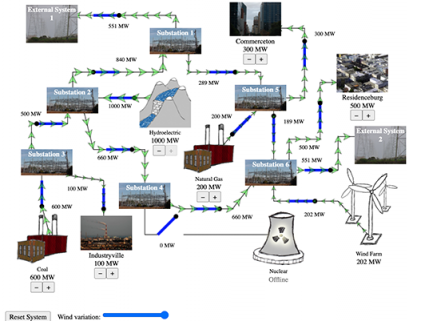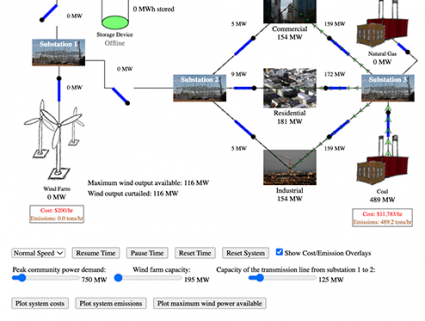Enter Tesla Town and explore electricity generation and delivery. Go into a hydroelectric power plant and see the turbine. Visit a solar powered house or a wind farm.
View various interactive activities related to electricity and the power grid.

Enter Tesla Town and explore electricity generation and delivery. Go into a hydroelectric power plant and see the turbine. Visit a solar powered house or a wind farm.

This lesson is designed to allow middle-school age or older students (and others) to explore power and energy usage in the home. Most power comes from a power plant to the home through a system of power lines, power substations, and transformers that make up the power grid. This simulation shows power flowing through the transformer drum, the meter, and into the home circuit breaker panel. From there, it powers various appliances. There is also an adjustable solar panel that can contribute to the home power demand or send power through the meter to be used by others.

Many electricity providers offer their customers time sensitive, or time of use, pricing plans. These plans reflect the actual cost of producing electricity at the time it is needed. They are designed to encourage customers to lower their electricity use during times when the cost of producing electricity is high. People and businesses use varying amounts of electricity throughout the day and power utilities adjust to these changing demands.

The power grid is the system of producers and consumers of electricity. It includes power generators, the users of electricity, switches that control the electricity, and the system of substations, power lines, and transformers that deliver the electricity. A community might have a generator to provide its power. The generator may be able to vary its production as the usage of the customers changes, but there may be times when the demand for energy is too great for the generator. Then the community buys electricity from another source.

This applet simulates a system that is owned by a power utility company. The company provides power to three communities. It owns and operates generators (which can be turned on and off in the exercise) and the transmission lines that serve the communities. On this system, it is usually possible for the utility company to supply all of the load demand using the local generators. However, there could be many reasons why this is not possible or most profitable, and then electricity is purchased from or sold to the external system.

Use this applet to explore some issues related to generation, demand, and transmission of electricity. When the applet opens, a coal powered generator and a natural gas generator are available to deliver electricity to three communities, but only the coal generator is producing. The wind farm is not yet connected to the system. As the demand from the communities changes over a 24-hour period, the generators adjust their power production. Fuel costs and carbon dioxide (CO2) emissions per hour for each of the generators is shown. The total peak demand for the communities is set to be 750 MW...